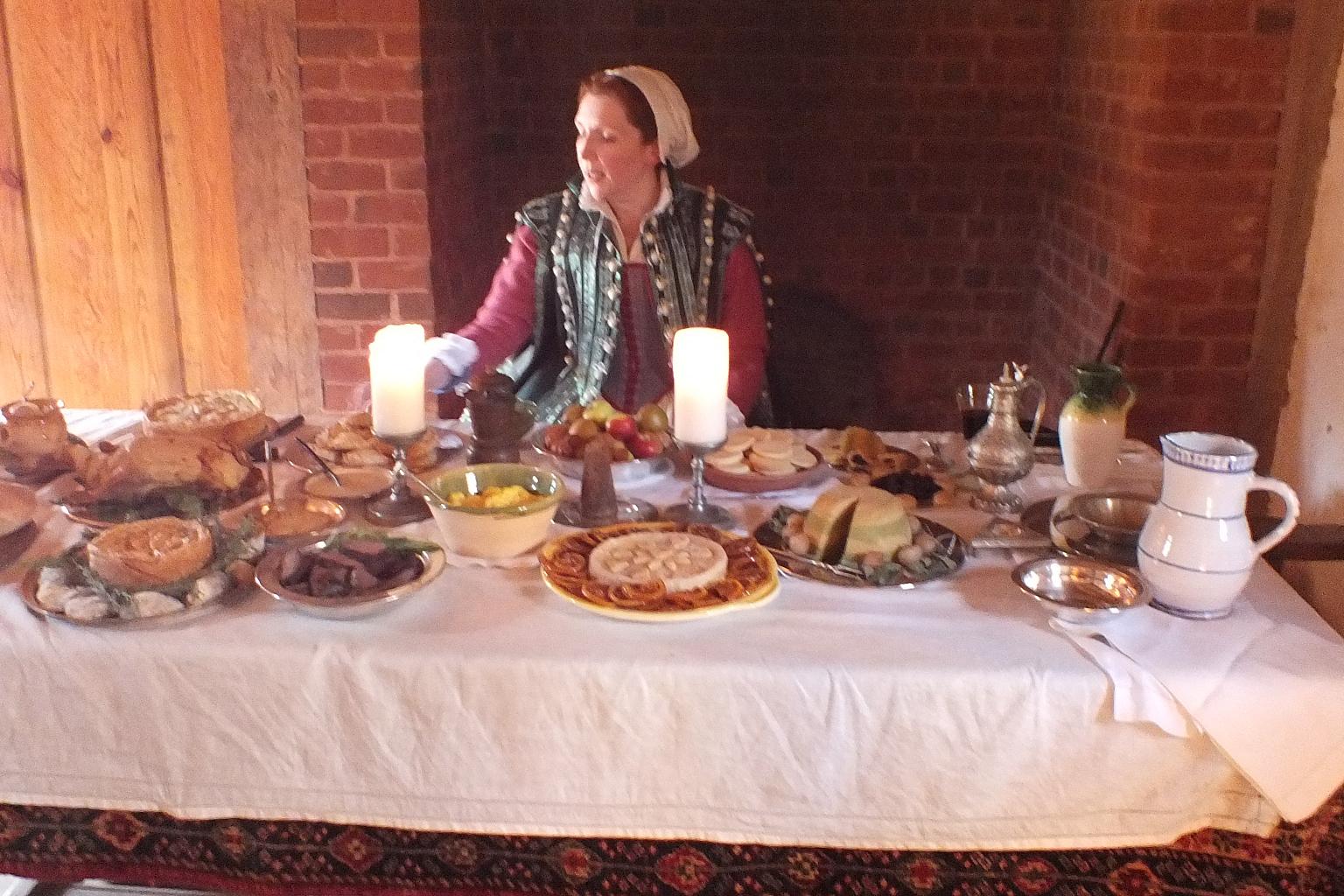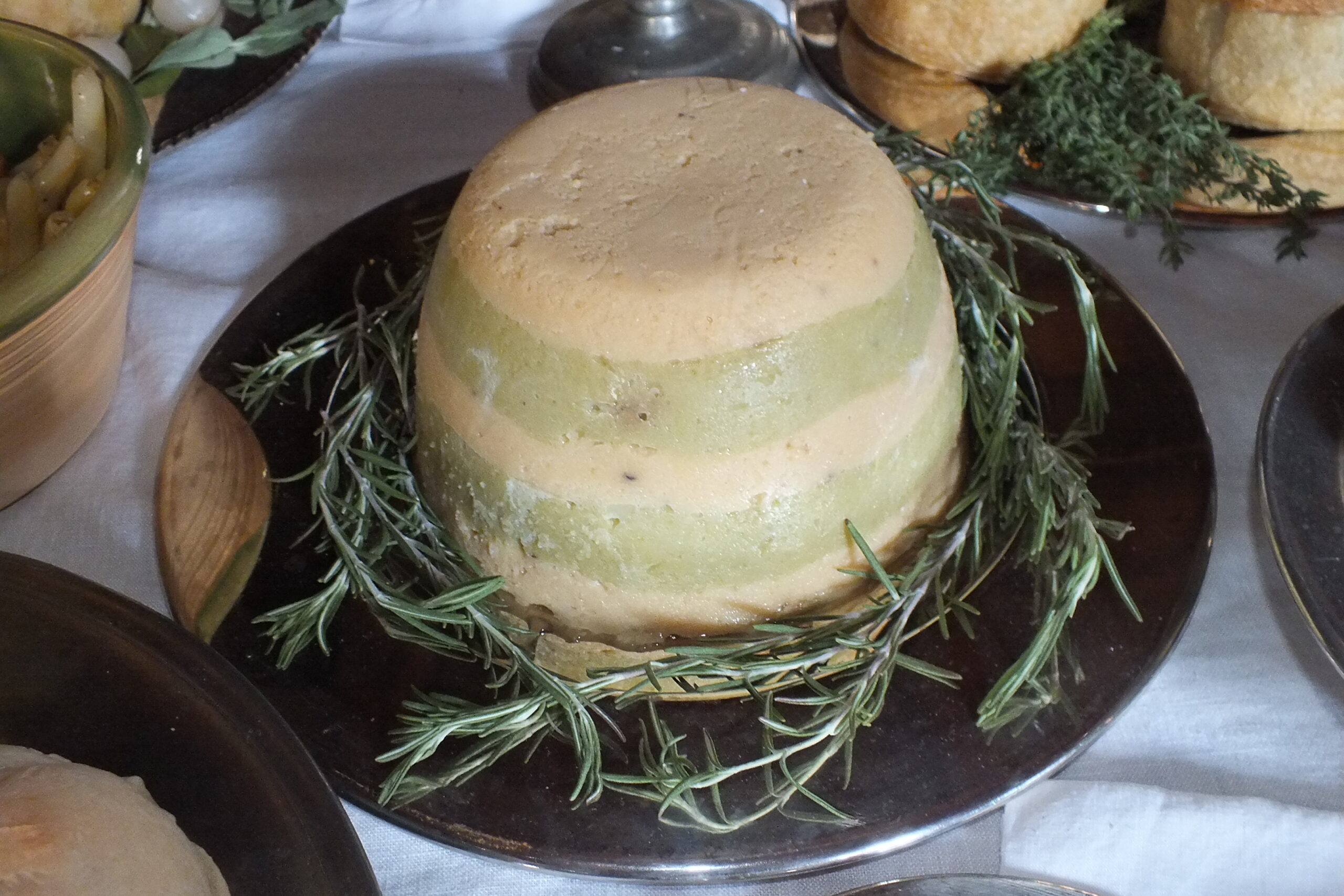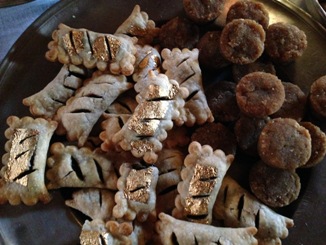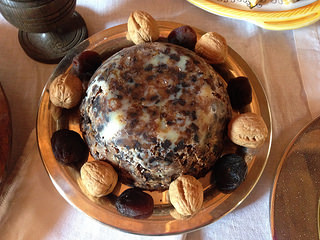We had an amazing turnout for Foods & Feasts, with Gardiner’s represented in almost every building at one point or another. I know I had a great time, and really enjoyed the questions from interested and engaged visitors. I also got some time with the chickens, which always makes me happy.
Robert and I worked the Governor’s House, with Gardiner’s members Greg and Alison, and Jamestown staff member, Samantha. I had the “Great Hall” for most of the two days, with a big layout of period foods, set up as if the Governor was about to eat the midday meal. This year I roasted a goose, made venison in red wine with a side of frumenty, a pease pudding, a fig pudding, meat pies, fresh-baked bread (in the popular “penny loaf” size), Banbury tarts, and sugar cakes. Bob polished the silver – no small feat, as almost the entire table was set with silver except for the salt cellar and flagon (both beautiful replicas by Steve Millingham Pewters), and a beautiful blue and white glazed pitcher (by Eadric the Potter).

Photos will be forthcoming, but I thought I’d get the ball rolling with the first of my recipes for the table.***
It’s a very old British dish: (Striped) Pease Pudding. (Side note: A friend was looking at my hand-written recipe, and she briefly thought it looked like “stupid pease pudding”. I thought that was hilarious. Aren’t you all glad I’m typing this out? My handwriting is illegible to me, half the time.)
Anyway…

Striped Pease Pudding
Ingredients:
1/2 lb yellow dried split peas
1/2 lb green dried split peas
2 tsp butter
2 eggs
2 chicken or vegetable bouillon cubes
salt and pepper to taste
water
lard to grease the pudding bowl
Utensils:
2 2-qt saucepans
2 medium bowls
sieve
1 ceramic small/medium pudding bowl (any ceramic bowl will do; the shape of the pudding is determined by the inside shape of the bowl).
aluminum foil
Large (6-qt) saucepan
Put the yellow peas in one pan, and the green peas in the other. Add 4 cups of water and one bouillon cube to each pan. Cook the peas until they are soft, which can take a while, so be patient. Keep adding more water as needed to cover the peas and allow them to cook evenly. Once they really start becoming mushy, lower the heat to a bare simmer, and cook, stirring often, until all the extra water is gone.
Sieve the peas separately into the medium bowls, making sure all the lumps are out. Allow to cool until barely warm. Add 1 egg, 1tsp butter, and salt & pepper to each bowl and whisk until the egg and butter are completely blended with the peas.
Grease the 1-qt bowl heavily (be generous; the pudding will be hard to unmold otherwise). Carefully layer the green and yellow peas 1-2″ deep into the pudding bowl, making sure not to put in too much of the peas at once, so that the layers don’t mix. Fill a third of the large saucepan with water. Cover the pudding bowl tightly with aluminum foil and place in the large saucepan, making sure the water is neither too high (it will get into the pudding and ruin it) nor too low (the pudding will burn). Bring the water to a boil, then lower to a simmer, cooking the pudding for 2 hours, adding water to the large saucepan if needed (be careful not to let it boil dry).
Allow the pudding to cool for about 20 minutes, then turn out onto a flat plate. Serve warm or cold (unmold the pudding while warm; store in the fridge), in slices.
There’s a picture of last year’s pease pudding under the December archives for 2013.
This pudding is one of the oldest traditional British puddings*; the earliest mention I found in my own books was in a cookery book from 1420**. It used to be made by putting whole dried peas (no egg!) into a linen bag, tying the top closed, and putting it into the pot where the meat was boiled for soup or stew. The peas would swell up and take on the flavour of the pork and seasonings. While not a fancy dish in the aforementioned form, when the peas are layered in colours of yellow and green before cooking so that the resultant dish is striped when cut into slices, it is far more elegant, and provides a welcome addition to pork and ham dishes.
If you feel brave, try making it the traditional way, and boil it in pork broth. Make sure the peas are given enough room to swell up in the bag; Dorothy Hartley (Food in England) says that it will come out as a round “cannon-ball” shape that you then crumble apart gently, and add butter. The broth provides the salt. Personally, I find that it needs more salt than just that provided by the broth, but I like my peas salty.
*The word “pudding” refers to the manner of cooking, not the flavour, in much the same way as “roast”. A pudding can be sweet or savoury, but it is always boiled in a water or stock bath. The use of “pudding cloths” is older than the use of pudding molds, but I follow the reasoning that molded foodstuffs like aspics and set puddings were considered an attractive addition to the 17th century table, so I cook my pudding using a bowl. I cannot document the use of specially shaped ceramic molds further back than the late 18th century, so even though I own a really pretty one, I don’t use it for Jamestown interpretation.
Sources:
** Two Fifteenth-Century Cookery-Books, Thomas Austin(ed.), printed for the Early English Text Society, Oxford University Press, 1888 (facsimile, Boydell & Brewer Ltd., New York, 2000).
Food in England, Dorothy Hartley, 1954, Macdonald & Co Ltd., London.
***Photos by Andrea Callicutt, added to post by Jen Thies










